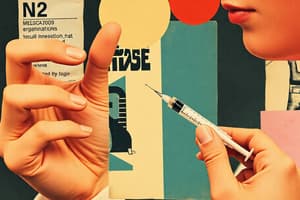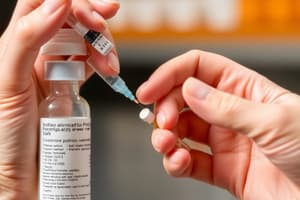Podcast
Questions and Answers
Which complication is specifically associated with intramuscular (IM) injections?
Which complication is specifically associated with intramuscular (IM) injections?
- Tissue necrosis (correct)
- Infiltration
- Phlebitis
- Air embolism
What is the appropriate angle of needle insertion for an intravenous (IV) injection?
What is the appropriate angle of needle insertion for an intravenous (IV) injection?
- 30 degrees
- 60 degrees
- 45 degrees (correct)
- 90 degrees
Which site is NOT commonly used for intramuscular injections?
Which site is NOT commonly used for intramuscular injections?
- Dorsogluteal site
- Ventrogluteal site
- Vastus lateralis site
- Deltoid site (correct)
What should be done after the medication is injected during an IV procedure?
What should be done after the medication is injected during an IV procedure?
Which complication can result from intravenous (IV) injections but not from IM injections?
Which complication can result from intravenous (IV) injections but not from IM injections?
How should a syringe be stabilized during an injection procedure?
How should a syringe be stabilized during an injection procedure?
Which complication can occur due to infiltration during an IV injection?
Which complication can occur due to infiltration during an IV injection?
Flashcards are hidden until you start studying
Study Notes
Injection Fundamentals
- Injection is the process of putting a liquid, especially a drug, into a person's body using a needle and a syringe.
- Parenteral medication is the administration of medication by injection into body tissues.
Routes of Parenteral Medication
- There are four routes of giving medication by injection:
- Intradermal (into the dermis layer below the epidermis of the skin)
- Subcutaneous (into the tissue below the dermis layer of the skin)
- Intramuscular (into the body muscle)
- Intravenous (into a vein)
Indications for Parenteral Administration
- Injections are usually used when:
- A rapid action is required
- The drug cannot be absorbed by the alimentary tract
- The patient is unable to take the medication orally
- The drug is not available in an oral form
Syringe
- A syringe has three parts: the tip (hub), the barrel, and the plunger
- There are three main types of syringe: Hypodermic syringe, Tuberculin syringe, and Insulin syringe
Purpose of Injection
- To get rapid and systematic effect of the drug
- To provide the needed effect when the client is unconscious
- To obtain local effect (e.g., xylocaine, tuberculin test)
- To restore blood volume by replacing the fluid
Equipment for Injection
- Tray
- Syringe
- Alcohol wipe
- Needle
- Gauze
- Torniquet
- Drug (checked)
- Prescription chart
- Gloves (if necessary)
Preparing Medication from Vial
- Flip the plastic cap off
- Pull back and fill the syringe with an amount of air equal to the amount of solution you want to draw
- Flick the side of the syringe to make air bubbles rise to the top
- Push needle through the rubber seal into the vial
- Pull back slowly on the plunger to withdraw
Intradermal (ID) Injection
- Administration of drug into the dermal layer of the skin just beneath the epidermis
- Small amount of liquid is used (e.g., 0.1ml)
- Syringe is positioned at 15 angles
- Common sites: Inner lower arm, Upper chest, Back beneath the scapula
- Indications: Tuberculin injection, Allergy sensitivity tests, Local anesthesia, BCG (Bacille Calmette Guerin Vaccine) for tuberculosis
- Complications: Pain, Irritant, Swelling, Infection
Procedure for Intradermal Injection
- Gather equipment
- Wash hands
- Explain procedure to the client
- Check and prepare the medication
- Provide privacy
- Select and clean the site of injection
- Grasp syringe with dominant hand
- Inject the medication
- Remove the needle slowly
Subcutaneous (SC) Injection
- Administration of medication into the subcutaneous tissue beneath the dermis layer of skin
- Used for slow, sustained absorption of medication
- Generally, a 2ml syringe is used, and only 0.5 – 1ml of medication is usually injected at 45 angles
- Common sites: Outer aspect of the upper arm, Anterior aspect of thigh, Abdomen (2-inch area surrounding the navel), Scapular area of the upper back, Ventrogluteal area, Dorsogluteal area
Procedure for Subcutaneous Injection
- Gather equipment
- Wash hands
- Explain procedure to the client
- Check and prepare the medication
- Provide privacy
- Select and clean the site of injection
- Grasp syringe with dominant hand
- Lift up a roll of skin and inject the medication
- Remove the needle slowly
Intramuscular (IM) Injection
- Injection of medication into the body muscles
- Intramuscular injection is absorbed more quickly than subcutaneous injection due to the greater blood supply to the body muscles
- Generally, a 2-5ml syringe is needed, and the size of the syringe depends on the amount of medication
- Angle of 90 degrees should be used
- Sites for intramuscular injection: Rectus femoris, Deltoid muscle, Dorsogluteal, Ventrogluteal, Vastus lateralis
Studying That Suits You
Use AI to generate personalized quizzes and flashcards to suit your learning preferences.




